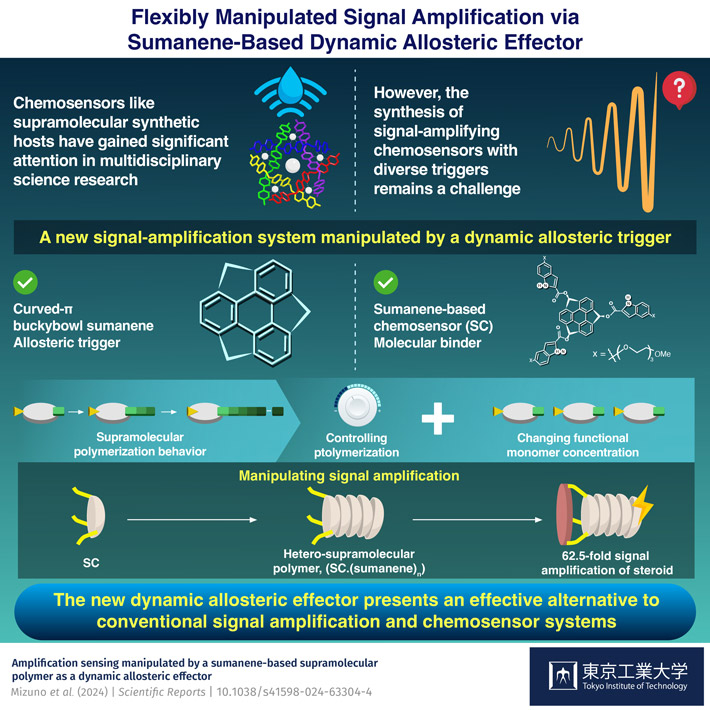Chemical sensors whose signals can be amplified by various triggers hold huge potential in multidisciplinary sciences. However, developing such systems was considered a highly challenging task, until a team of researchers from Tokyo Tech recently came up with a novel signal-amplification system that can be flexibly manipulated by a dynamic allosteric effector or a trigger. This new chemosensor system exhibited exception signal amplification by altering the sumanene monomer concentrations.

Synthetic supramolecular hosts and artificial receptors have found an exciting application in the form of chemical sensors or chemosensors, which hold the potential to change the field of molecular recognition and real-time biomedical sensing. They are based on the fundamental lock-and-key working principle where a specific chemical substrate perfectly fits into the active site of an enzyme (host), thus, leading to a specific chemical reaction that creates a signal necessary for sensing purposes.
The lock-and-key model, however, has its share of disadvantages, and an effective way to deal with them is to enhance the signal by improving the binding constant between the host and the target molecule. Biological systems are known to amplify their binding constant via a process known as allosterism. To ensure that the chemosensor is more sensitive and efficient, scientists have been looking for ways to amplify the signal and are on the lookout for signal-amplifying chemosensors that can be manipulated by various allosteric effectors or triggers.
To aid this effort, researchers from Tokyo Institute of Technology(Tokyo Tech), led by Associate Professor Gaku Fukuhara, in collaboration with Osaka University, presented in a recent study published on 31 May 2024, the discovery of a new nature-surpassed signal-amplification system that can be flexibly manipulated by a dynamic allosteric effector or trigger.
“Supramolecular polymers consist of a functional monomer that spontaneously stacks on each other through noncovalent interactions. It is assumed that the degree of polymerization can be manipulated by changing the monomer concentration. We used this knowledge to make dynamic changes in the allosteric effector,” replied Fukuhara when asked about their modus operandi.
For the first time, the team obtained an allosteric trigger using curved-π buckybowl sumanene as the monomer for supramolecular polymerization. They also incorporated a sumanene-based chemosensor (SC) into the system due to sumanene’s ability to spontaneously polymerize as supramolecules in solutions. Additionally, the pristine sumanene molecule is known to gradually stack on the convex face of the chemosensor to form hetero-supramolecular polymers (SC·(sumanene)n), which the researchers found was also responsible for the degree of signal-amplification.
The team also found that the degree of polymerization could be changed by controlling the degree of monomer effector and subsequent flexible manipulation of electronic properties at the binding site. The exceptional signal-amplification system exhibited by the system could be attributed to the fluorescence changes upon the complexation of guest molecules.
To test the applicability of the system on biologically important materials and generalize the current signal-amplification method, the team used steroids like testosterone, corticosterone, and allylestrenol as target molecules. The experiments revealed that changing the sumanene monomer concentration led to a 62.5-fold signal amplification of a steroid.
The sensing strategy proposed in this study can act as a guideline for further development of sensors for diverse guests that are difficult to recognize via use of conventional lock-and-key type chemosensors. “Our chemosensor system is a powerful tool that demonstrated the effectiveness of supramolecular polymerization adjustments as a mode of manipulation signal amplification. It can thus open new avenues for the development of alternate chemosensors and signal-amplification systems triggered by various triggers,” concludes Fukuhara.
Reference
Authors : | Hiroaki Mizuno1, Hironobu Nakazawa2, Akihisa Miyagawa3, Yumi Yakiyama2,4, Hidehiro Sakurai2,4, and Gaku Fukuhara1* |
Title : | Amplification sensing manipulated by a sumanene-based supramolecular polymer as a dynamic allosteric effector |
Journal : | Scientific Reports |
DOI : | |
Affiliations : | 1 Department of Chemistry, Tokyo Institute of Technology, Japan. 2 Division of Applied Chemistry, Graduate School of Engineering, Osaka University, Japan. 3 Department of Chemistry, Faculty of Pure and Applied Sciences, University of Tsukuba, Japan. 4 Division of Applied Chemistry, Graduate School of Engineering and Innovative Catalysis Science Division, Institute for Open and Transdisciplinary Research Initiatives (ICS‑OTRI), Osaka University, Japan. |








